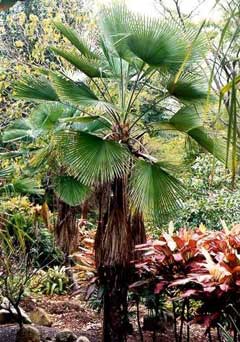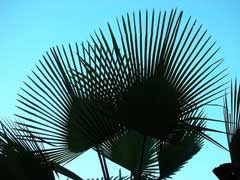 |
|
|
 |
| www.flickr.com/photos/anua22a |
Translate this page:
Summary
Physical Characteristics

 Trachycarpus martianus is an evergreen Tree growing to 12 m (39ft) by 2 m (6ft) at a slow rate.
Trachycarpus martianus is an evergreen Tree growing to 12 m (39ft) by 2 m (6ft) at a slow rate.
See above for USDA hardiness. It is hardy to UK zone 8. It is in leaf all year, in flower from August to September. The species is dioecious (individual flowers are either male or female, but only one sex is to be found on any one plant so both male and female plants must be grown if seed is required). and is pollinated by Insects. The plant is not self-fertile.
Suitable for: light (sandy), medium (loamy) and heavy (clay) soils. Suitable pH: mildly acid, neutral and basic (mildly alkaline) soils. It can grow in semi-shade (light woodland) or no shade. It prefers moist soil.
UK Hardiness Map
US Hardiness Map
Synonyms
Plant Habitats
Woodland Garden Sunny Edge; Dappled Shade; Shady Edge;
Edible Uses
Edible Parts: Leaves Shoots
Edible Uses:
Fruit- raw or cooked The flesh is scanty and almost tasteless[2]. The following notes are for the closely related T. fortunei. They almost certainly also apply to this species[K]. Young flower buds - cooked[2, 105, 178]. Used like bamboo shoots[183]. The fresh flowers and terminal bud are also apparently consumed[183].
References More on Edible Uses
Medicinal Uses
Plants For A Future can not take any responsibility for any adverse effects from the use of plants. Always seek advice from a professional before using a plant medicinally.
Astringent Contraceptive Haemostatic
The following notes are for the closely related T. fortunei. They almost certainly also apply to this species[K]. The flowers and the seed are astringent and haemostatic[147, 218]. The root or the fruit is decocted as a contraceptive[147, 218]. The ashes from the silky hairs of the plant are haemostatic[147, 218]. Mixed with boiling water they are used in the treatment of haemopytsis, nose bleeds, haematemesis, blood in stools, metrorrhagia, gonorrhoea and other venereal diseases[147].
References More on Medicinal Uses
The Bookshop: Edible Plant Books
Our Latest books on Perennial Plants For Food Forests and Permaculture Gardens in paperback or digital formats.

Edible Tropical Plants
Food Forest Plants for Hotter Conditions: 250+ Plants For Tropical Food Forests & Permaculture Gardens.
More

Edible Temperate Plants
Plants for Your Food Forest: 500 Plants for Temperate Food Forests & Permaculture Gardens.
More

More Books
PFAF have eight books available in paperback and digital formats. Browse the shop for more information.
Shop Now
Other Uses
Fibre Weaving
The following notes are for the closely related T. fortunei. They almost certainly also apply to this species[K]. The fibres from within the leafstalk are used for making brushes, ropes, coarse cloth etc[231]. A matting is made from the bark admixed with some of the stem fibres[178]. The leaves are woven into hats, rough coats and fans[46, 61, 178].
Special Uses
References More on Other Uses
Cultivation details
Requires a rich moist but well-drained soil in a sunny sheltered position[188, 231], especially from the cold drying winds of the north and east[11]. Individual leaves live for about 3 years and, if they are damaged by wind will make the plant look very shabby as well as reducing its potential for photosynthesis[231]. Hardy in the southern part of Britain, tolerating frosts down to between -5 and -10°c if the plant is sheltered from cold winds[200, 260]. Young plants require protection during winter[11]. Palms usually have deep penetrating root systems and generally establish best when planted out at a young stage. However, older plants are substantially more cold tolerant than juvenile plants[231]. In areas at the limit of their cold tolerance, therefore, it is prudent to grow the plants in containers for some years, giving them winter protection, and only planting them into their permanent positions when sheer size dictates[231]. Palms can also be transplanted even when very large. Although the thick fleshy roots are easily damaged and/or desiccated, new roots are generally freely produced. It is important to stake the plant very firmly to prevent rock, and also to give it plenty of water until re-established - removing many of the leaves can also help[231]. Very closely related to T. fortunei, one of the main differences being that, unlike T. fortunei, the fibres from the leaf stalks do not persist on this species[231]. The plant is also slower growing, though it is eventually much taller than T. fortunei[260]. Dioecious. Male and female plants must be grown if seed is required.
References Carbon Farming Information and Carbon Sequestration Information
Temperature Converter
Type a value in the Celsius field to convert the value to Fahrenheit:
Fahrenheit:
The PFAF Bookshop
Plants For A Future have a number of books available in paperback and digital form. Book titles include Edible Plants, Edible Perennials, Edible Trees,Edible Shrubs, Woodland Gardening, and Temperate Food Forest Plants. Our new book is Food Forest Plants For Hotter Conditions (Tropical and Sub-Tropical).
Shop Now
Plant Propagation
Scarify or pre-soak the seed for 24 hours in warm water then sow in a cold frame in mid to late winter. Bring into the greenhouse about 4 - 6 weeks later and the seed should germinate in about 4 - 8 weeks at 25°c[133]. As soon as they are large enough to handle, prick the seedlings out into individual pots and grow them on in the greenhouse for at least their first winter. Plant them out into their permanent positions in late spring or early summer, after the last expected frosts. Consider giving the plants some protection from the cold for at least their first winter outdoors. Pot up suckers in late spring and plant out in their permanent position 12 months later.
Other Names
If available other names are mentioned here
Native Range
TEMPERATE ASIA: China (s.-c.) TROPICAL ASIA: India (northeast), Nepal, Myanmar (north)
Weed Potential
Right plant wrong place. We are currently updating this section.
Please note that a plant may be invasive in one area but may not in your area so it's worth checking.
Conservation Status
IUCN Red List of Threatened Plants Status :

Growth: S = slow M = medium F = fast. Soil: L = light (sandy) M = medium H = heavy (clay). pH: A = acid N = neutral B = basic (alkaline). Shade: F = full shade S = semi-shade N = no shade. Moisture: D = dry M = Moist We = wet Wa = water.
Now available:
Food Forest Plants for Mediterranean Conditions
350+ Perennial Plants For Mediterranean and Drier Food Forests and Permaculture Gardens.
[Paperback and eBook]
This is the third in Plants For A Future's series of plant guides for food forests tailored to
specific climate zones. Following volumes on temperate and tropical ecosystems, this book focuses
on species suited to Mediterranean conditions—regions with hot, dry summers and cool, wet winters,
often facing the added challenge of climate change.
Read More
Expert comment
Author
(Wall.)H.A.Wendl.
Botanical References
200
Links / References
For a list of references used on this page please go here
Readers comment
| Add a comment |
|
If you have important information about this plant that may help other users please add a comment or link below. Only comments or links that are felt to be directly relevant to a plant will be included. If you think a comment/link or information contained on this page is inaccurate or misleading we would welcome your feedback at [email protected]. If you have questions about a plant please use the Forum on this website as we do not have the resources to answer questions ourselves.
* Please note: the comments by website users are not necessarily those held by PFAF and may give misleading or inaccurate information.
To leave a comment please Register or login here All comments need to be approved so will not appear immediately.
|
Subject : Trachycarpus martianus
|
|
|
|